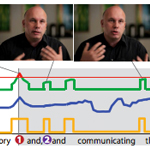
Seamless Video Editing – A Look Toward the Future
A computer application creates seamless transitions and tells you when to cut. Will this technology shape the video editing future?
What if a computer editing application could tell you where to make your video cuts? A new application being developed by researchers at UC Berkely and Adobe Systems aims to do just that…helping editors identify the best spot to make a cut based off of audio and visual features of raw footage. The program can auto generate seamless transitions to make the cuts visually smooth and undetectable.

In recent years, audio transcription technology has advanced (for instance, the speech transcription tools in Adobe Premiere Pro and Audition CS6 software). This seamless video editing technology is an extension of what we’re seeing in those speech recognition tools, as it pairs the transcription back to the video image and analyzes it to find areas for optimal cutting. From the project’s research paper:
“We present a hierarchical, graph-based algorithm for efficiently generating hidden transitions that considers visual features specific to interview footage. We also describe a new data-driven technique for setting the timing of the hidden transition.”
In layman’s terms: Spots of the video where there is little audio or on-screen movement are given priority as ideal spots to cut, and are plotted on a “cut suitability” timeline. If necessary the application will insert natural looking pauses to bridge two cuts together. From the product demo (embedded below) it appears that editors can simply delete text from the transcript view and the application will go to work creating a seamless transition. An additional features allows for one-click removal of “ums” and repeated words.
This tech seems useful for working with on-camera interviews (with only one subject), but in it’s current state it doesn’t seem like it would be effective at tackling more complex shooting situations.
The project is in current development and will be presented at SIGGRAPH 2012. One of the leads on the project is a research scientist in the Creative Technologies Lab at Adobe, which begs the question… Is this technology in development for inclusion in future versions of Adobe video editing applications?
Get more details and all the technical specs at Floraine.org
What do you think of this new technology?
Let us know in the comments!





